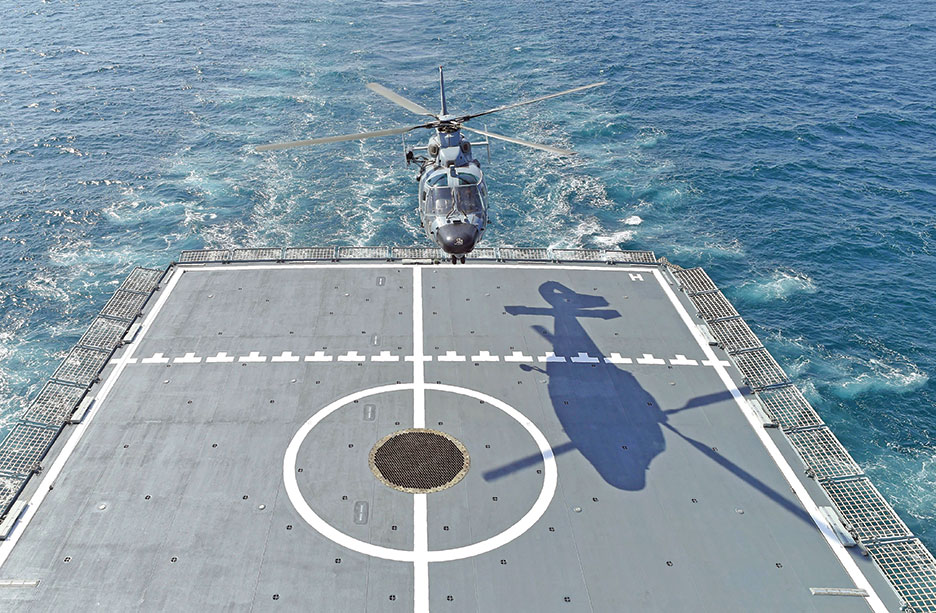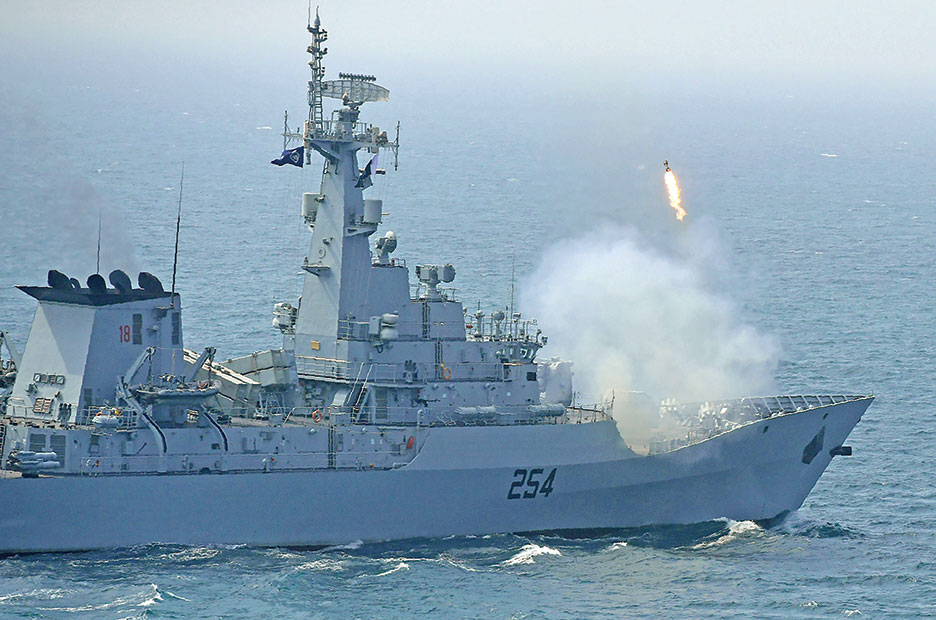Naval cooperation with partner nations ensures a more secure Indian Ocean and Arabian Sea
photos by AFP/Getty Images
The sea has traditionally been a medium of contrasts. Its seemingly placid surface yields easily to an undulating intensity, and it doesn’t take long for gale force winds to develop into destructive storms. An unruffled sea one moment, and not long after, triggered by a massive underwater earthquake, a tsunami sweeps countless shores with unrelenting fury.
And when it comes to human activity on the seas, legitimate commerce operates side by side with illegal trafficking.
The stakes these days are considerably higher. The global economy relies on international trade, of which as much as 85 percent is conducted through the medium of the seas. Threats to the global socio-economic order don’t stem from just piracy as in the past but are now so diverse in character that it has led many analysts to dub oceans the “biggest crime scene in the world.”
The vastness of the interconnected oceans, with enforcement and jurisdiction challenges of their own, offers an appetizing opening to organized criminal enterprises to benefit from, by stealthily operating under the radar, so to speak. The use of inconspicuous vessels for undertaking such illegal activities compounds problems related to policing and detection.
Stopping and searching commercial vessels on mere suspicions of crimes cause unacceptable disruptions to world trade. In the Arabian Sea, dhows, extensively used for legitimate coastal trade, have been enlisted to traffic in contraband cargo. Boats designed for fishing, an activity that provides livelihoods to about 12 percent of the global population, are known to be used in various illegal acts, such as piracy and drug smuggling, on the side.

The bombing of the USS Cole while at anchor at Yemen’s Aden harbor in 2000 and the oil tanker MV Lindberg off the coast of Yemen in 2002 — both rammed by explosives-laden dinghies — brought the specter of maritime terrorism to center stage.
The world reacted by strengthening global maritime security through individual and coordinated efforts. The approval of the International Ship and Port Facility Security Code in December 2002, as an amendment to the existing Safety of Life at Sea Convention 1974, incorporated mandatory security requirements and implementation guidelines to signatory governments, port authorities and shipping companies.
There is no doubt, however, that the one sure way of effectively confronting the multitude of threats disturbing the good order at sea is through concerted action featuring a collaborative approach.
Somali piracy in the Gulf of Aden and the western Indian Ocean was curbed in large part by the convergence of warships from as many as 29 countries. Operating either singly or in groups like the European Union’s Operation Atalanta, NATO’s Operation Ocean Shield or the Combined Task Force, they were bound by a shared objective.
Regional initiatives like the International Maritime Organization’s Djibouti Code of Conduct also played a significant role in this endeavor. The Jeddah amendment of 2017 has widened the scope of the alliance to include combating all illegal activities at sea, not just piracy.
Recognizing that maritime security would remain a mirage if it wasn’t backed up by actionable intelligence, the Republic of Singapore Navy took the much-needed initiative to set up an Information Fusion Center in April 2009 at its Changi Naval Base. This regional center has by now established linkages with 71 operation centers from 38 countries, with 16 international liaison officers based there as well.
Another notable regional initiative has been that of the Indian Ocean Naval Symposium (IONS). Fashioned after the Western Pacific Naval Symposium, IONS has attracted not only the Indian Ocean littoral states, but also welcomes extraregional countries with a stake in the region. The Conclave of Chiefs, which forms an integral part of every biennial symposium, ensures that views are exchanged and coordinated responses are crafted at the highest naval level.
The overarching objective of the conference is to create and act upon a unified plan of action against a multitude of maritime security challenges plaguing the region.
With the redesignation of the United States Pacific Command as the Indo-Pacific Command in 2018, the interest of the U.S. in the region in general and IONS in particular is bound to increase.
Pakistani-U.S. relations have witnessed many ups and downs over the years, but one area where interests have always coincided is that of the sea. In fact, it was a Central Treaty Organization (CENTO) naval exercise in Pakistani waters in November 1963 that facilitated the maiden entry of the U.S. Navy into the Indian Ocean.
This was followed by a stopover at the port of Karachi in August 1964 of three newly built nuclear-powered vessels — the USS Enterprise, Long Beach and Bainbridge — during their unprecedented around-the-world unrefueled cruise to demonstrate the efficacy of nuclear propulsion.
U.S. Navy warships continued to be a familiar sight in the North Arabian Sea. Port calls at Karachi were invariably followed by passage exercises or by a series of bilateral exercises named Inspired Siren. It was in one of the latter exercises in 1995 that a U.S. warship, using its shipborne helicopter and a trained boarding party, successfully demonstrated the concept of vessel board, search and seizure. This has considerably assisted the Pakistan Navy in refining its procedures to undertake search operations at sea safely and effectively.
And indeed, when Combined Task Force 150 was set up in the wake of the United Nations-sanctioned invasion of Afghanistan, the Pakistan Navy had no qualms in offering its services and had no problems integrating itself into the workings of this task force. The Pakistan Navy went on to command this force, whose area of operations included some of the world’s busiest sea lanes, a record 11 times.
When another Combined Task Force — CTF 151 — was established in January 2009 to pursue a specific counterpiracy mandate, the Pakistan Navy not only signed on immediately, but has commanded it eight times. The experience gained by the Pakistan Navy through participation in these task forces has enabled it to further fulfill its international obligations by launching the Regional Maritime Security Patrols.
The Pakistan Navy solidified its credentials as a force for good by initiating a series of biennial exercises named Aman (Peace), the first of which was held in early 2007. The sixth in the series, held in February 2019 and written about in this issue of Unipath, brought together as many as 45 countries on a common platform of pursuing the cause of peace at sea.
It is always heartwarming to see representatives from disparate countries braving political divides to attend conferences, briefings, food galas and international cultural displays in the same spirit that their warships undertake an international fleet review at sea.
Nontraditional challenges at sea have not only proliferated over the years but tend to crop up in areas where they face the least resistance. In a canvas as vast as the sea, its resident challenges, being transnational by nature, are bound to be complex enough to test the limits of an individual navy or other maritime law enforcement agency. Surveillance, vigilance, maritime patrols, intelligence gathering and info sharing are all naval missions required to be undertaken in a well-coordinated manner if the genie of instability at sea is to be kept bottled up.
Whereas land divides, it is said, the sea unites. And such unity is critical if the global objective of freedom of navigation, to the exclusion of all else, is to be realized. Pacem in Maribus — Peace on the Seas — can only come about if all responsible coastal states reach across the sea to clasp hands in the pursuit of a common purpose. F

